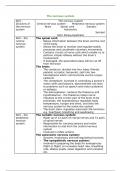Other
AQA A Level Psychology Biopsychology Essay Plans
- Module
- Biopsychology
- Institution
- AQA
Concise, detailed essay plans covering the whole AQA A Level Psychology Biopsychology topic, created and used to achieve an A* in the 2024 Psychology A Level exam series.
[Show more]



